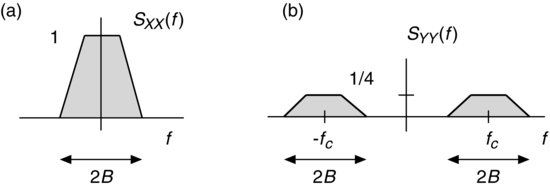8.9 PASSBAND SIGNALS
So far, we have focused on random signals whose PSDs are located at the origin which are referred to as baseband signals. In most communication systems, one is interested in signals whose PSDs are located about some center frequency fc, where typically ![]() . Such signals are called passband signals. Figure 8.14 provides examples of SXX(f) for baseband and passband signals. Observe that the one-sided bandwidth (for
. Such signals are called passband signals. Figure 8.14 provides examples of SXX(f) for baseband and passband signals. Observe that the one-sided bandwidth (for ![]() ) of the baseband signal is B whereas it is 2B for the passband signal. The reason for this is that a passband signal is often generated from a baseband signal via modulation of a sinusoidal signal with carrier frequency fc. Typically, for a passband signal the bandwidth is
) of the baseband signal is B whereas it is 2B for the passband signal. The reason for this is that a passband signal is often generated from a baseband signal via modulation of a sinusoidal signal with carrier frequency fc. Typically, for a passband signal the bandwidth is ![]() , for which case it is called a narrowband passband signal.
, for which case it is called a narrowband passband signal.
Figure 8.14 PSDs. (a) Baseband random process X(t). (b) Passband random process Y(t) obtained by modulating X(t).

Let X(t) be a random process with baseband PSD SXX(f) and one-sided bandwidth B. Suppose X(t) is multiplied by a sinusoidal waveform with known carrier frequency fc:
In order to determine SYY(f), the autocorrelation ...
Get Probability, Random Variables, and Random Processes: Theory and Signal Processing Applications now with the O’Reilly learning platform.
O’Reilly members experience books, live events, courses curated by job role, and more from O’Reilly and nearly 200 top publishers.

